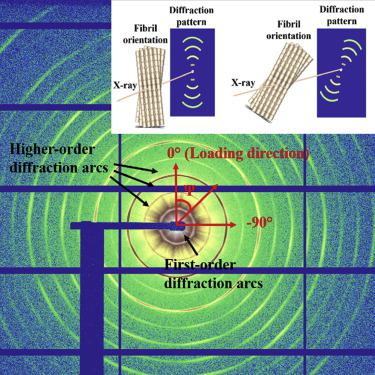Matter ( IF 17.3 ) Pub Date : 2020-06-05 , DOI: 10.1016/j.matt.2020.05.011 Haocheng Quan , Wen Yang , Marine Lapeyriere , Eric Schaible , Robert O. Ritchie , Marc A. Meyers

|
The carp (Cyprinus carpio) has typical elasmoid scales commonly found on teleosts. They provide protection while retaining flexibility and maneuverability of the fish. The exterior surface of the scale consists of an ultrathin discontinuous mineral layer on top of mineralized woven collagen fibrils. The underlying foundation is composed of two collagenous components. The major one consists of a single-twisted “Bouligand” structure with a twisting angle of 36°. A secondary “sheet-like” structure, formed by thinner collagen fibrils oriented along the thickness direction, acts to increase the integrity of the scale. Here, we identify the deformation and failure mechanisms of the carp scale, revealing slight tensile anisotropy. Using in situ small-angle X-ray scattering during tensile testing, the toughening mechanisms of the scale, including the adaptive structural reorientation of lamellae as well as fibrillar sliding and elastic deformation, are quantified and compared with those of other fish scales.
中文翻译:

现代鲤鱼鳞鱼鳞的结构和机械适应性
鲤鱼(Cyprinus carpio)具有典型的硬骨鱼鳞鳞片。它们在保持鱼类柔韧性和可操作性的同时提供保护。秤的外表面由一层超薄的不连续矿物质层组成,位于矿化的编织胶原纤维的顶部。基础粉底由两个胶原成分组成。主要的是由单扭的“ Bouligand”结构组成,扭角为36°。由沿厚度方向定向的较薄的胶原纤维形成的二级“片状”结构可增加水垢的完整性。在这里,我们确定了鲤鱼鳞的变形和破坏机理,揭示了轻微的拉伸各向异性。原位使用 在拉伸试验过程中通过小角度X射线散射,对鱼鳞的增韧机理(包括薄片的自适应结构重新定向以及纤维状滑动和弹性变形)进行了量化,并与其他鱼鳞进行了比较。































 京公网安备 11010802027423号
京公网安备 11010802027423号